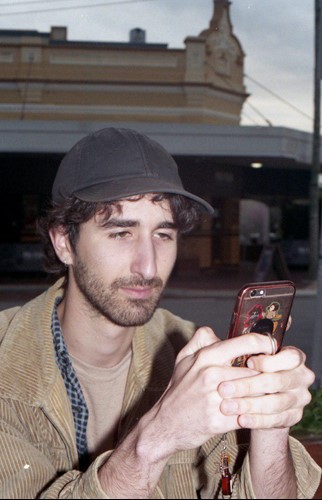A biologist, an engineer and an artist walk into a bar
Art meets science in an ambitious new installation from WA’s Nathan Thompson, Guy Ben-Ary and Sebastian Diecke that brings microscopic ‘biobots’ to life inside a custom-built ceramic incubator.
For Bricolage, the artists have bio-engineer individual cellular units from blood, silk and heart muscle, which self-assemble into intriguing living and kinetic sculptural forms large enough to see with the naked eye.
This thought-provoking exhibition invites us to consider the human body in a world beyond its control.
The following observations are by Paul Boyé, a member of the inaugural Visual Arts Writing Group.
Bricolage runs until 22 March at Fremantle Arts Centre.
Image: Fremantle Arts Centre Opening, cr. Pixel Poetry
Image: Fremantle Arts Centre Opening, cr. Pixel Poetry
OBSERVATIONS BY PAUL BOYE
A biologist, an engineer and an artist walk into a bar. The wooden countertop peels back to reveal a stainless-steel bench, the taps becoming microscopes, the bar stools are now pottery wheels. A difficult neurologist sits at the bar and holds her latest screenplay, shouts “action!”, and into the lab walk several million mould spores. Cells of literally all kinds are differentiating, constructing the stage for the great tragicomedy of living and dying. No longer just the space for a joke but a mongrel menagerie of unlikely mates, coalescing and celebrating their timely yet temporary unions, disagreements and obscure cadences.
To say ‘art meets science’ is to situate at least two barely-contained bodies, words which refer to fields that inherently rely on experimenting with material, practice, ethics and vision. The work of bioart (although this does not limit the possibilities of ‘art meets science’) is the work of resplendent and challenging conversation, mutation and co-habitation. And in these times of ecological trouble such co-habitation, along with new practices of observation and listening, are increasingly necessary.
![]()
Image: Fremantle Arts Centre Opening, cr. Pixel Poetry
Bricolage is an installation work that employs a custom-built ceramic incubator that nurses to life specifically bio-engineered cellular structures – what the artists call ‘bio-bots’ – derived from blood, silk and heart muscle. The bio-bots, as they grow, assume several different shapes; they are kinetic and sculptural entities that emerge as a consequence of self assembly. It is difficult to predict what forms will emerge out of the process of self-assembly, and it is this performance of material interaction that the viewer is invited to observe.
To emphasise the self-assembling bio-bots concert, the artists have deliberately reduced the presence of a technological edifice to a bare minimum. This decision rehearses a common problem that crosses the sciences and the art – the use and reliance on instruments. However, in an attempt to pare back the focus and possible fetishisation of instruments, Bricolage is designed to allow the viewer to perceive the bio-bot performances with the ‘naked eye’ – the cells twitch, wiggle and conglomerate in front of the viewer.
This performance forms a relationship with our systems of perception; the cellular structures within our bodies perform their own roles in tandem with the bio-bots. As light bounces off the surface of the wriggling cellular forms, it meets our retinas, and the cone and rod cells within our eyes perform their systematic response. The paring back of instrumentality reduces the mediation of this performance. Complex, yet fundamentally simple material interactions, are what Bricolage stages, breaking the normalised limits of the human body outside its perimeter.
![]()
Image: Fremantle Arts Centre Opening, cr. Pixel Poetry
The phrase ‘building blocks of life’ is a common metaphor to render how the molecular contributes to molar form – small things gather to make a larger thing and it’s particularly special when the larger thing is more than the sum of the bits that make it, it. Bricolage intervenes and challenges this ‘building-block’ concept by simulating the molecular-into-molar process of large-thing creation. In doing so, the work not only makes visible usually invisible steps in this process, but also stages a performative role for materials that are typically subordinated to the larger thing, or in this case, the larger life-form.
Bricolage is a novel and exciting approach to many of the problems encountered by scientists and artists alike. Viewing and mingling with the sculptural bio-bots decentres the relevance and place of the human body as a measure. The larger thing, the human, is positioned to apprehend a group of kinetic and performing smaller things that enjoy an ambiguous agency despite their modest material form. Moving itinerantly through environments of living and dying, we encounter systems that rouse us; we are troubled, scared yet energised and validated all in the same movement. Bricolage stages a peculiar yet simple simulation of our environment of muddled systems, shifting our observational norms and yielding a novel perspective of ecological empathy and ambiguous companionship. A co-habitation of things, larger and smaller, artistic and scientific, ordered and chaotic.
ABOUT PAUL BOYE

Paul Boyé is a writer and artist living and working in Boorloo (Perth, Western Australia). They are currently a committee member at Cool Change Contemporary, PhD Candidate at UWA School of Design and the co-editor of Cactus Journal.